Module 5
1. Module 5
1.4. Page 4
Module 5: Angles
Bringing Ideas Together
right angle: one-quarter of a complete rotation
It is 90° in measure.
acute angle: an angle greater than 0° but less than 90°
This is an acute angle.
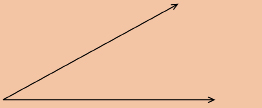
obtuse angle: an angle greater than 90° but less than 180°
This is an obtuse angle.

straight angle: one-half of a rotation; an angle of 180°
This is a straight angle.
![]()
reflex angle: an angle having a measure greater than 180° but less than 360°
This is a reflex angle.

full rotation: an angle having a measure of 360°
This is a full rotation angle.
![]()
In Getting Started and Explore, you reviewed the parts of an angle, how they are measured, and what referents may be used to estimate their size. Before adding to your estimation skills, you will revisit how angles are classified by measure.
In Explore, you began by folding a sheet of paper to divide one complete rotation into quarters.
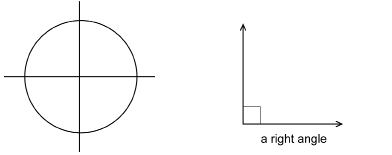
Each of the four angles was ![]() in measure.
in measure.
Most home designs involve countless right angles. Walls and floors meet at right angles—corners are square. A small square is often drawn between the arms of a right angle.
Use the applet “Acute Angle” to investigate acute angles. As you drag the movable dot to change the angle size, watch for a colour change in the text. Between what degrees is an angle considered acute? What happens if the angle is greater than 90°?
The word acute means “sharp.” Do you agree this is an appropriate name to describe what you now know as acute angles?
Use the applet “Obtuse Angle” to investigate obtuse angles. Between what degrees is an angle considered obtuse?
You should now be able to define the term obtuse angle.
Did You Know?
The word obtuse means “dull.”
Use the applet “Straight Angle” to investigate straight angles, which are a type of angle that can look like a simple straight line.
Another type of angle is a reflex angle. Use the applet “Reflex Angle” to investigate this type of angle.
Estimating Angle Measures with Referents
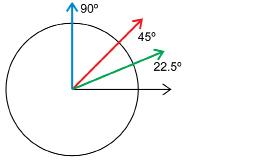
Next, you will estimate angles using the referents you discovered in Explore. You will need the circle diagram you prepared through paper folding and the triangle containing the 30° and 60° angles.
Look at your circle diagram again.
The 45° angle (red) is ![]() .
.
The 22.5° angle (green) is ![]() .
.
If you were to place 30° and 60° on the circle, those angles would divide the right angle into three parts.
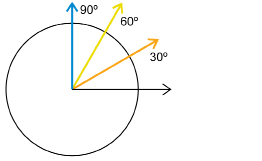
The 30° angle (orange) ![]() .
.
The 60° angle (yellow) ![]() .
.
So, 30°, 60°, and 90° are also useful benchmarks or referents.
Study the following examples to hone your estimation skills. You will be working with acute, obtuse, and reflex angles. You will need a protractor to check the accuracy of the estimates.
Example 1
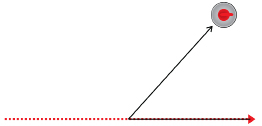
A curling stone strikes a rock in the house and is deflected from its original course.
-
State whether the angle is acute, obtuse, or reflex.
-
Estimate the angle at which the stone was deflected.
-
Measure the angle to check your estimate.
Solution
-
Because the angle is less than 90°, the angle is acute.
-
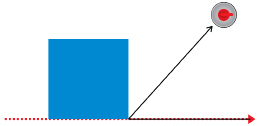
If a square corner from a sheet of paper is placed on the figure as shown, the angle appears to be just a little larger than of a right angle. Since
of a right angle. Since  × 90° = 45° (the referent), the angle may be 50° in measure.
× 90° = 45° (the referent), the angle may be 50° in measure.
-
With a protractor, the angle measures 48°.
Example 2

A proton is fired from the left at the nucleus of a gold atom. The ray with the double arrow head shows the original course the electron would have taken in the absence of a collision. The electron is scattered from its original course as shown by the ray with the single arrow head.
-
State whether the angle is acute, obtuse, or reflex.
-
Estimate the scattering angle.
-
Measure the angle to check your estimate.
Solution
- The angle is greater than 90° but less than 180°, so the angle is obtuse.

If the corner of a sheet of paper is placed on the angle, it looks as though the small angle between the dashed line and the arm of the angle is about of a right angle (22.5° is the referent). So, the scattering angle is about 22.5° less than 180°. Since 180° – 22.5° = 157.5°, an estimate is 157°.
of a right angle (22.5° is the referent). So, the scattering angle is about 22.5° less than 180°. Since 180° – 22.5° = 157.5°, an estimate is 157°.
- Using a protractor, the angle measures 155°.
Example 3
A wrench is turned counterclockwise to loosen a bolt through an angle, as shown in the following graphic.
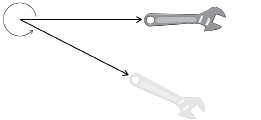
-
State whether the angle is acute, obtuse, or reflex.
-
Estimate the angle.
-
Use a protractor to check your estimate.
Solution
-
The angle is greater than 180° but less than 360°. The angle is a reflex angle.

If the square corner of a sheet of paper is positioned at the vertex as shown, the small angle appears to be of a right angle (30° is the referent). So the reflex angle is about 30° less than one full rotation, 360° – 30° = 330°.
of a right angle (30° is the referent). So the reflex angle is about 30° less than one full rotation, 360° – 30° = 330°.
- Using a protractor, the small angle is 27°. So, the reflex angle is 333°.
 Self-Check
Self-Check
Do these questions. When finished, check your answers.
Use these guidelines for each angle in the questions.
- Describe the angle as acute, right, obtuse, straight, reflex, or a full rotation.
- Use a referent to estimate the measure. State the referent you used: 22.5°, 30°, 45°, or 60°.
- Use a protractor to check your estimate.
SC 3. 
SC 4. 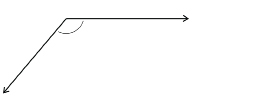
SC 5. 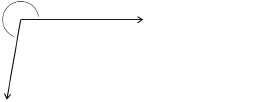
SC 6. 
 Mastering Concepts
Mastering Concepts
You have seen that referents help in estimating the measure of an angle, but you can also estimate angles using a ruler.
Here is another method for estimating acute angles. You will need a ruler.
Step1: Draw any acute angle.

Step 2: From the vertex, measure out 6 cm along each arm and mark these points A and B as shown.

Step 3: Measure the distance between A and B to the nearest tenth of a centimetre.
Step 4: Multiply the distance between A and B by 10. That is the measure of the angle within a degree or two. For example, if AB = 2.3 cm, then an estimate of the angle would be 2.3 × 10 = 23°.
Step 5: Check with a protractor to see how close the estimate is.
Use these steps with several acute angles. Then, answer the following questions to see why the steps work. When finished, check your answers.
MC 1. Points A and B are 6 cm from the vertex. If you drew a circle centred at the vertex and passing through A and B, what is the circle’s approximate circumference?
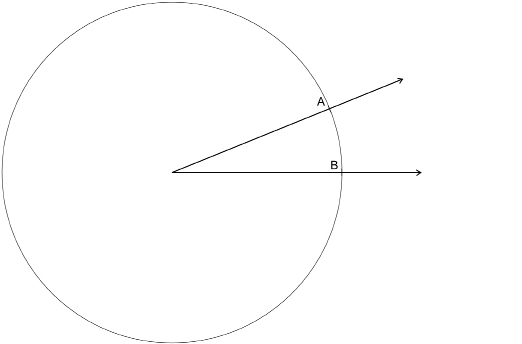
MC 2. What is 10 times this circumference?
MC 3. How does the number of degrees in a circle compare to your answer in question MC 2?